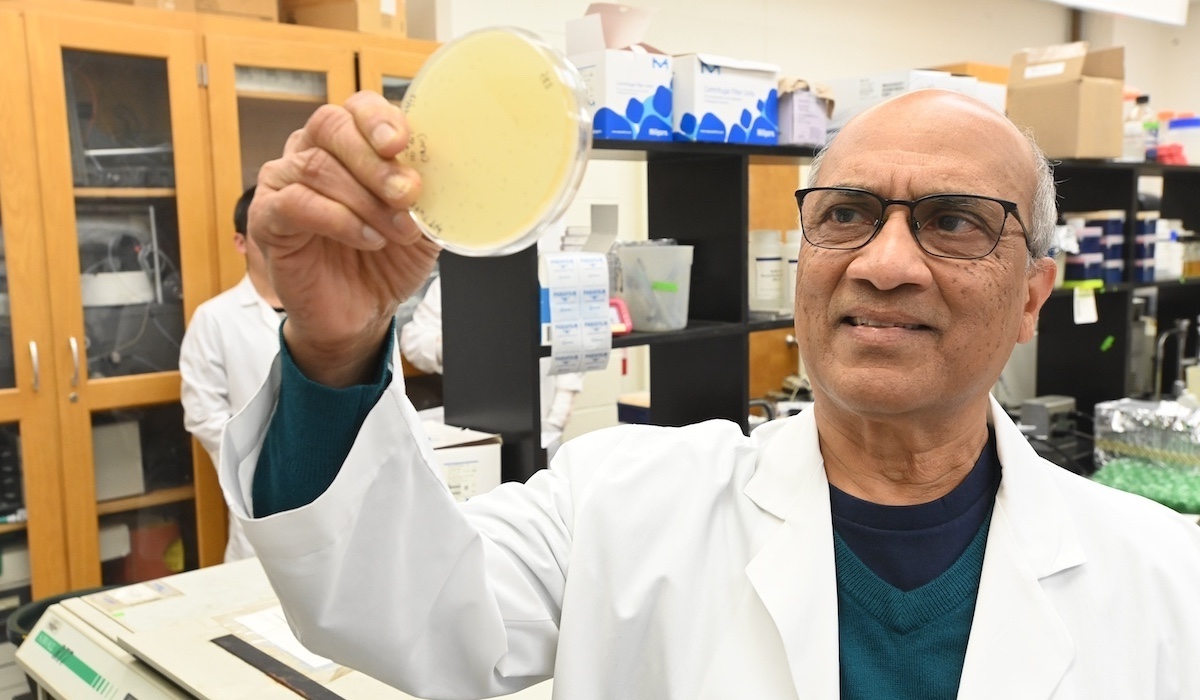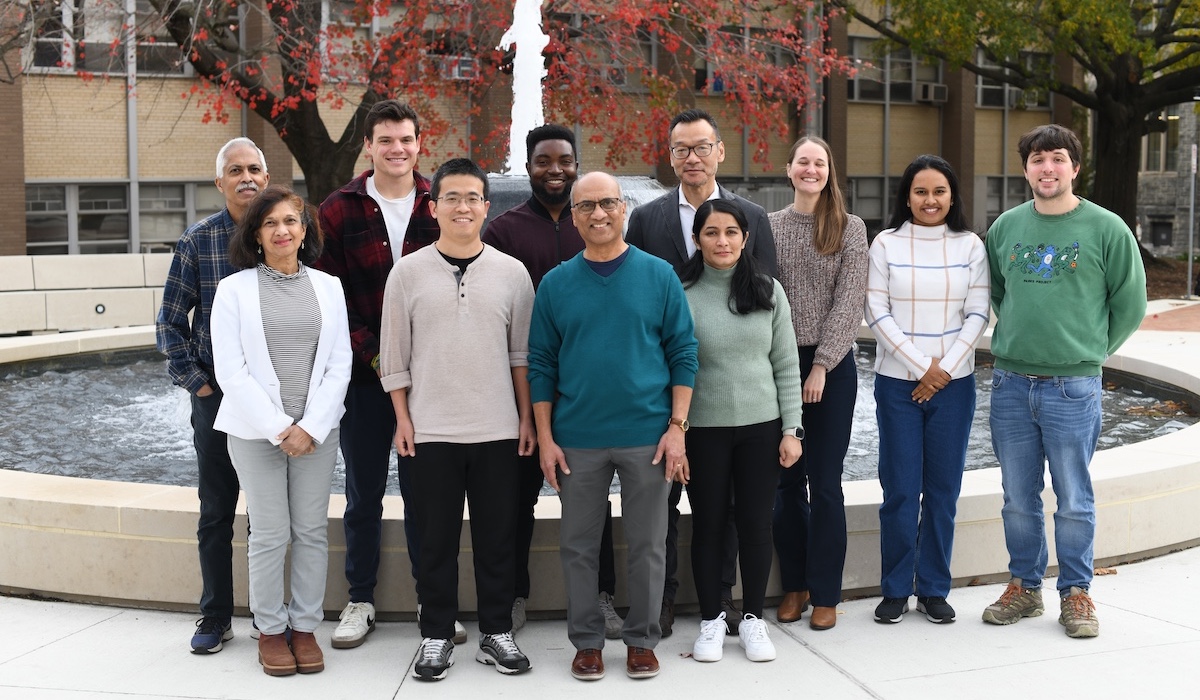


Building a Legacy at Catholic University
University Professor Venigalla B. Rao joined the faculty in the Department of Biology at Catholic University in 1989. He served as Director of Graduate Programs from 1995-2019 and Department Chair from 2001-2019. Today, Dr. Rao serves as the founding Director of the Bacteriophage Medical Research Center, established by the University in 2021. His work continues to address pressing global health challenges through groundbreaking research.
A Lifelong Journey into Bacteriophage Research
Dr. Rao’s fascination with bacteriophages (phages) began as a Ph.D. student in biochemistry at the Indian Institute of Science in Bangalore, India. After completing his dissertation, he joined Dr. Lindsay Black’s laboratory at the University of Maryland Medical School to study T4 bacteriophage DNA packaging. At the time, very little was known about how viruses package their genetic material.
Through meticulous research, Dr. Rao identified key packaging components and developed biochemical assays to study this process in a test tube. His collaboration with Dr. Black resulted in the first biochemical papers on T4 genome packaging, laying the foundation for his future career.
Unraveling the Mysteries of Bacteriophage T4
Dr. Rao describes bacteriophage T4 as a complex structure consisting of at least 38 types of proteins and over 3,900 protein molecules. Derived from the Greek word phageîn, meaning "to eat or devour," bacteriophages are viruses that infect bacteria. They are among the most common entities on earth, are a hundred times smaller than bacteria, and are found wherever bacteria exist.
Billions of phages live in and on the human body, including in our guts, blood, and skin, as well as in soil, sewers, and every body of water on the planet. However, they do not pose a threat to humans because they do not recognize human cells as prey.
“The precision, perfection, and efficiency with which T4 assembles such beautiful and complex structures in such a short time frame (20-30 minutes) are fascinating and mind-boggling,” says Dr. Rao. Bacteriophages can assemble as many as 200 new phages in a single E. coli bacterium.
Using cutting-edge cryo-electron microscopy technology, Dr. Rao’s team recently generated the entire T4 phage structure at atomic level resolution. They have captured 3D coordinates of millions of atoms that form the complete structure of phage T4. While this work marks a major achievement, Dr. Rao acknowledges that fully decoding and understanding the structure will take years.
The Engineering Marvel of T4 Assembly
Bacteriophage architecture bears a striking resemblance to that of a lunar landing module. Dr. Rao explains that T4 Bacteriophages have an icosahedral (20 faces) head or capsid containing its DNA. Attached to the head is an elongated tail and a baseplate to which six symmetrical leg-like tail fibers are attached. These fibers interact with bacterial surface receptors to determine the specificity of the bacterium host.
When the phage encounters a bacterium host, it injects its entire genetic material within a single minute. After injecting the DNA material, the phage assumes control of the host cell and replicates itself. Extreme proliferation causes the bacterium host to burst (lyse), releasing new phages to infect neighboring bacteria. Dr. Rao said this phase is the lytic (virulent) life cycle.
Dr. Rao explains that a massive amount of highly acidic genetic material (DNA) of the virus is packaged within each bacteriophage T4 head. This material is condensed to a density equivalent to a DNA crystal, and the pressure inside the head is 5-6 times the pressure in a champagne bottle.
T4 assembles a highly reinforced shell structure to withstand the pressure and employs a powerful motor to pump the DNA genome into the bacterium through a tiny syringe-like channel.
Dr. Rao and his team analyze phage motors at a single molecule level and have generated atomic-level structures. Dr. Rao says, “Phage T4’s packaging motor is the fastest and most powerful motor known to date. It has twice the power of an automobile engine.”
Breakthroughs and Challenges in Phage Research
In the late 90s and early 2000s, Dr. Rao explained that researchers in the field struggled to produce crystals of the packaging motor to determine the atomic structure. He recalled spending many years producing numerous mutants of the motor and collaborating with Dr. Michael Rossmann (Purdue University) in pursuit of developing packaging motor crystals. Their efforts finally paid off in 2007. Drs. Rao and Rossmann successfully generated T4 phage motor crystals, and within two weeks, the very first viral motor packaging structure was solved to near-atomic resolution.
This was a pivotal moment in Dr. Rao’s career. “The structure confirmed virtually every prediction we made before using genetic and biochemical approaches,” said Dr. Rao.
During that period, Dr. Rao began considering using the power of the T4 DNA packaging machine to potentially deliver genes into human cells to cure genetic diseases.
Dr. Rao recalls having made many unsuccessful attempts to demonstrate gene delivery. In 2012, his team finally succeeded in seeing a signal for gene delivery into cultured human cells using the T4 packaging machine!
Overcoming Challenges in Studying T4
The research being conducted in the Bacteriophage Medical Research Center is a highly competitive area, and securing funding is a challenging enterprise. According to Dr. Rao, researchers must be in the top 10% to get grant funding from the National Institutes of Health (NIH).
But despite the challenges, Dr. Rao remains optimistic. He says his love of science is the incentive that motivates him to become more resourceful, strategic, and focused.
Dr. Rao’s research has been continuously funded both by the National Institutes of Health and the National Science Foundation.
The Bacteriophage Medical Research Center is now positioned to harness decades of knowledge to create nanomachines in test tubes that can deliver genes into human cells and replace defective genes.
Bacteriophages in the Fight Against Antibiotic Resistance
T4 bacteriophage is one of the most well-understood viruses. By translating the accumulated knowledge of this virus, Dr. Rao’s team at the Center is developing various platforms for biomedical applications, such as vaccine design, gene therapy, and phage therapy to kill antibiotic-resistant pathogens.
Unlike the current phage therapy models, the T4 virus is engineered to seek out the infectious pathogen, attach to it, and deliver certain molecules to kill (lyse) the pathogen. In this approach, Dr. Rao says, “We believe that deep learning and engineering of one virus can lead to the treatment of multiple diseases.”
Empowering the Next Generation of Scientists
When asked what he finds most rewarding about his job, Dr. Rao responded, “First and foremost, the opportunity for continuous learning and the freedom to pursue unprecedented scientific challenges.” Mentoring students and budding researchers is also near and dear to Dr. Rao’s heart.
When asked to describe the learning environment of his classroom, Dr. Rao explains that the classroom is a space where the instructor and students learn from the exchange of shared information. He says active participation is paramount in his classroom. Dr. Rao encourages his students to go beyond the limitations of classroom instruction and share what they learn in classroom discussions.
In addition to traditional teaching practices, Dr. Rao attests to self-study as an effective approach to student learning. His students are required to not only research topics but they must share their findings in multiple formats. He explains, "In my Viruses and Vaccines class, students must research a medically relevant virus, give a brief presentation, and construct a model of the virus.” Dr. Rao’s office is adorned with various model viruses designed by his students.
According to Dr. Rao, that approach fosters self-learning, leads to student empowerment, and develops analytical and communication skills, which are not always conducive in traditional classrooms.
Dr. Rao views the natural world as a source of inspiration, and he is attuned to the infinite knowledge it imparts. He says he directs his energies to problem-solving during major crises or global challenges. Throughout his expansive career, Dr. Rao says that he has come to regard any challenge as an opportunity to learn something new. According to Dr. Rao, “A crisis is a portal for evolution and transformation.”
Dr. Rao offers this advice to students when an experiment renders an unfavorable result: “Step back, reevaluate the process, and search for what nature is trying to reveal.”
Dr. Rao credits his students and research fellows, who worked tirelessly on developing a non-infectious, bacteriophage T4-based nasal COVID-19 vaccine. As fate would have it, Dr. Rao was on sabbatical at the height of the COVID pandemic but returned to intense research, guiding the team that led to the development of a groundbreaking COVID-19 vaccine.
The Future of Bacteriophage Research and Phage Therapy
“The future of phage research is replete with endless possibilities,” Dr. Rao says. Phages are the smallest and most ubiquitous “organisms” on Earth and offer unlimited potential to learn about biology, about us, and to open new and powerful avenues for biomedicine. Dr. Rao believes that phages might, in the near future, be broadly administered as vaccines, antimicrobials, and gene therapeutics to cure cancers, deadly bacterial infections, and genetic diseases. To that end, Dr. Rao says, the mission of the Bacteriophage Medical Research Center is to improve the human condition with these life-saving therapies.
The Role of Faith in the Quest for Life-Saving Therapies
Dr. Rao asserts that the transcendence of concepts and mental constructs are driving forces behind his research. Dr. Rao considers it an honor and feels enormous gratitude for having been given the opportunity to “observe the deepest levels of one of nature’s beautiful creations, the bacteriophage T4”. In drawing from this body of knowledge, Dr. Rao says he’s hopeful that life-saving therapies will emerge, and that hope makes his research such an inspiring journey!
Awards and Accolades
Of the many awards and accolades Dr. Rao has received, he confessed that he’s particularly excited about the $5 Million Avant-Garde Grant from the National Institute on Drug Abuse (NIDA). The NIDA Avant-Garde Award Program for HIV and Substance Use Disorder Research supports scientists of exceptional creativity who propose high-impact research that will open new areas of HIV research and lead to new avenues for the prevention and treatment of HIV among people who use drugs.
Dr. Rao says he is poised to return to the bench in the spring and build his research team for this monumental project to establish new phage-based technologies for treatments and cures of HIV and genetic diseases.
A complete list of Dr. Rao’s awards and accolades can be found on the following links:
National and International Awards
- Fellow of the American Academy of Microbiology (2021)
- Fellow of the National Academy of Inventors 2021
- Nominated for the 2021 GenScript MolecularCloud Distinguished Research Award
- NIDA Avant-Garde Award for HIV Research
- Awarded $5 Million Government Grant for HIV/AIDS Research
- U.S. and International Patents
Catholic University Awards
- Inaugural Faculty Research Achievement Award (2009)
- Arts & Sciences James Youniss Research Award (2021)
- Inaugural Newton-Bennett Award for Exceptional Achievement (2024)
Beyond the Lab
In his spare time, Dr. Rao enjoys backyard gardening and is an avid cyclist and runner. He is also a certified yoga instructor. These hobbies reflect his holistic approach to life, balancing scientific rigor with personal well-being.
Dr. Rao’s legacy at Catholic University and in the field of phage biology and therapy reflects his relentless curiosity, innovative spirit, and dedication to improving the human condition.
__________
Mrs. Terrie Gomillion-McPherson is an Instructional Project Coordinator at CTE.
